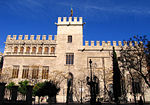Institut Valencià d'Art Modern
Institut Valencià d'Art ModernUse mdy dates from August 2021

The Institut Valencià d'Art Modern (Valencian pronunciation: [instiˈtud valensiˈa ˈðaɾd moˈðɛɾn]; Spanish: Instituto Valenciano de Arte Moderno; English: "Valencian Institute of Modern Art"), also known by the acronym IVAM, was the first center of modern art created in Spain, opening in 1989 in the city of Valencia. The Institut Valencià d'Art Modern is an important center for modern and contemporary art in Spain and Europe. Nuria Enguita Mayo is the Director of the museum since September 2020.
Excerpt from the Wikipedia article Institut Valencià d'Art Modern (License: CC BY-SA 3.0, Authors, Images).Institut Valencià d'Art Modern
Carrer de Na Jordana, Valencia Ciutat Vella
Geographical coordinates (GPS) Address Website External links Nearby Places Show on map
Geographical coordinates (GPS)
| Latitude | Longitude |
|---|---|
| N 39.48 ° | E -0.382778 ° |
Address
Institut Valencià d'Art Modern
Carrer de Na Jordana 118
46003 Valencia, Ciutat Vella
Valencian Community, Spain
Open on Google Maps











